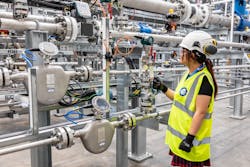For optimum measurement performance, a flowmeter should be calibrated as close to service conditions as possible. However, that presents numerous challenges. One immediate issue is that the pressure, temperature and fluid properties of a process fluid may differ considerably from typical calibration laboratory conditions.
Most flow calibration facilities will offer a calibration at close to ambient conditions — with either water or possibly a low-viscosity oil. The historical practice for calibrating flowmeters has been to attempt to match fluid viscosity followed by, if possible, the fluid temperature and pressure. Matching all parameters has seldom been possible due principally to limitations set by the existing calibration facilities. Limitations such as flow rate range, temperature range, pressure range and even the calibration fluid’s physical properties mean that few laboratories can meet all customer requirements.
Does that mean that you cannot use your flowmeter for process measurements unless it has been calibrated at the exact same conditions as it undergoes in situ? Not quite. Some flowmeters can be calibrated at relatively similar process conditions and simply operate with a much higher measurement uncertainty. Another way to think of it is that the measurement would simply be less accurate and more prone to mismeasurement. Now, this certainly would not be acceptable for the measurement of high-value products such as oil and gas due to safety, legal and tax implications. However, for some measurements, such as low-value products and batch processes, it may be acceptable to have a significantly larger measurement uncertainty.
For these types of applications where the measurement uncertainty is not quite so critical, there is the possibility of calibrating a flowmeter at conditions that are not an exact replication of the service conditions. For that to be possible, the selected flowmeter must have a relatively low sensitivity to a variety of process effects.
One such possible candidate is the Coriolis flowmeter. Various industries such as oil and gas, food and beverage and pharmaceuticals are increasingly installing Coriolis flowmeters as an alternative to the more traditional turbine, differential pressure and positive displacement meters. This is because Coriolis flowmeters can deliver direct mass flow and density measurement of the fluid as well as inferred volumetric flow. These more advanced flow measurement technologies also offer diagnostic capabilities and have few installation requirements.
Some flowmeters require multiple lengths of straight pipework upstream and downstream of the device to ensure adequate performance. Coriolis flowmeters are not overly affected by installation and, as such, can be installed in a variety of challenging locations.
However, one of the key benefits of Coriolis flowmeters is that they can measure liquids or gases without any modification or adjustment. They are fairly unique in this regard. Furthermore, they can measure water, light oils and even viscous fluids. With no moving parts, the devices are not adversely affected by viscous fluids clinging to rotating shafts and gears.
Few other technologies can provide such flexibility with regard to the fluid being measured. When a Coriolis flowmeter is manufactured, the device undergoes a factory calibration — with water flow to derive the calibration coefficients for that unit. This meter could then theoretically be used to measure a variety of fluids of differing fluid viscosities and densities. However, the measurement uncertainty could be extremely large depending on the process conditions.
In terms of pressure and temperature effects, Coriolis meters are not immune to physical changes due to variations in operating conditions. It is known that the Young’s modulus of the flow tubes will alter with increasing and decreasing temperature and pressure. This change to the tube stiffness results in an increase or decrease in the twisting or phase shift of the Coriolis device. Bent-shape (also known as curved or U-tube) Coriolis flowmeters appear to exhibit a linear under-read with respect to pressure. Straight-tube devices appear to exhibit a linear over-read with respect to pressure. Furthermore, axial forces acting on the measuring tubes due to pressure and temperature have also been researched.
To accommodate these effects, Coriolis manufacturers have corrections incorporated in the flow computer of the device for temperature and pressure variations. These values are often published in the flowmeter manual. The robustness of these corrections still requires further research and analysis. Furthermore, while Coriolis meters have a resistance thermometer (RTD) within the device that measures the temperature of the flow tubes, there is no such sensor for pressure. To correct for pressure effects, the user must input the operating pressure into the flow computer or provide a pressure measurement for an online correction.
Transferring from one fluid to another
So, what about flowmeter calibration transferability? Several factors must be considered before simply calibrating a Coriolis flowmeter at one condition and then using the device at a vastly different process condition.
Calibrating a Coriolis flowmeter for gas use can be challenging due to cost, availability of a traceable flow facility and even recreating service conditions such as pressure. However, one of the most challenging issues is the markedly different mass flow range. While temperature, pressure and fluid properties do not necessarily need to be perfectly matched for larger measurement uncertainty applications, the flow range is a different matter. The flow range of a process should be as closely matched as possible. For example, if operated at 15 to 75 kilograms per second (kg/s), then the calibration flow range should be almost identical. However, when operating in gas rather than water, the mass flow rate would be substantially lower. This is because the mass of gas is considerably lower than a liquid.
So, what’s the solution? Can a Coriolis flowmeter be calibrated in water and then used to measure gas? Theoretically, the answer is yes. However, the measurement uncertainty would likely be extremely large (greater than 1%), and there is also the question of traceability. Traceability provides the confidence in a measurement. For example, if a flowmeter is calibrated using the UK’s National Standard for oil flow measurement at TÜV SÜD National Engineering Laboratory Oil Flow Measurement Facility, then subsequent measurements with that device are traceable back to the UK National Standards for flow. That provides confidence to the end user and to other parties.
Ideally, before using the meter to measure gas, the device should be calibrated in both water and then gas flow. A comparison of the performance can be made and, so long as the permissible measurement uncertainty is met, then future calibrations may be completed in water only. This provides a substantial saving to the end user due to the reduced need for regular calibration with gas.
Future research
At present, there is not enough independent traceable data available to allow Coriolis flowmeters to be used for gas flow measurement with only a water calibration. Little evidence exists for the devices being able to transfer from water to gas without a substantial effect on the measurement uncertainty. However, this is due to a lack of research rather than a lack of acceptable results.
To address this issue, TÜV SÜD National Engineering Laboratory will be researching the transferability of a water calibration to a gas calibration with several Coriolis flowmeters of differing sizes. To ascertain whether the performance remains valid, the meters will undergo calibrations at a range of flow rates.
Does the pressure difference between water and gas affect the performance? Will the vastly different Reynolds number affect the Coriolis output? These questions can be answered through further research and analysis of repeat calibrations.
TÜV SÜD National Engineering Laboratory’s previous research indicates that although pressure effects are the most significant, temperature and viscosity/Reynolds number may have an impact and should be considered. A Coriolis flowmeter can be corrected for pressure using a traceable pressure correction coefficient. The preferred method would use a dynamic live correction via a pressure transmitter. A pressure measurement at the Coriolis flowmeter is either supplied to the Coriolis transmitter or to a flow computer in order to adjust the meter for the effects of pressure. The meter compensation coefficient would still be a set value, but the amount of adjustment to the Coriolis flowmeter will vary with the measured pressure.
It is also important to remember that performance of Coriolis meters from one manufacturer to another can be very different due to variables such as aspect ratio, model design and patented corrections, alongside the differing quality of internal research and development that has been completed.
As we have seen, the temperature, pressure and fluid properties of process fluids can differ considerably from standard calibration laboratory conditions. Thus, the methodology for calibrating and operating Coriolis meters at alternative conditions requires further research.
Dr. Chris Mills is a consultant engineer at TÜV SÜD National Engineering Laboratory, a provider of technical consultancy, research and development, calibration and testing services. Part of the TÜV SÜD Group, the organization is a global center of excellence for flow measurement and fluid flow systems and is the UK’s Designated Institute for Flow Measurement. Mills is a chartered chemical and process engineer with over 12 years of experience in flow measurement. He has practical experience with calibrating and operating flowmeter technologies: Coriolis, positive displacement, ultrasonic, turbine and differential pressure devices. Mills recently completed his engineering doctorate with Coventry University on laminar-turbulent transitional flow measurements.
About the Author
Chris Mills
Dr. Chris Mills is a consultant engineer at TÜV SÜD National Engineering Laboratory, a provider of technical consultancy, research and development, calibration and testing services. Part of the TÜV SÜD Group, the organization is a global center of excellence for flow measurement and fluid flow systems and is the UK’s Designated Institute for Flow Measurement. Mills is a chartered chemical and process engineer with over 12 years of experience in flow measurement. He has practical experience with calibrating and operating flowmeter technologies: Coriolis, positive displacement, ultrasonic, turbine and differential pressure devices. Mills recently completed his engineering doctorate with Coventry University on laminar-turbulent transitional flow measurements.

